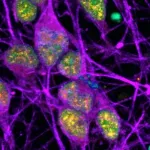(Press-News.org) In the year since the coronavirus pandemic upended how just about every person on the planet interacts with one another, video conferencing has become the de facto tool for group collaboration within many organizations. The prevalent assumption is that technology that helps to mimic face-to-face interactions via a video camera will be most effective in achieving the same results, yet there's little data to actually back up this presumption. Now, a new study challenges this assumption and suggests that non-visual communication methods that better synchronize and boost audio cues are in fact more effective.
Synchrony Promotes Collective Intelligence
Researchers from Carnegie Mellon's Tepper School of Business and the Department of Communication at the University of California, Santa Barbara, have studied collective intelligence--the ability of a group to solve a wide range of problems--and how synchrony in non-verbal cues helps to develop it. There are many forms of synchrony, but the common view is that synchrony occurs when two or more nonverbal behaviors are aligned. Essentially, conversation is what happens when at least two speakers take turns sharing their thoughts, and nonverbal cues are how they establish when and how to take these turns.
Previous research has shown that synchrony promotes collective intelligence because it improves joint problem solving. So it's not too far-fetched that many would assume that if a conversation can't take place face-to-face, it would be best simulated with both video and audio software.
The researchers focused on two forms of synchrony: facial expression synchrony and prosodic synchrony. Facial expression synchrony is pretty straightforward and involves the perceived movement of facial features. Prosodic synchrony, on the other hand, captures the intonation, tone, stress, and rhythm of speech. They hypothesized that during virtual collaboration, collective intelligence would develop through facial expression synchrony when the collaborators had access to both audio and visual cues. Without visual cues, though, they predicted that prosodic synchrony would enable groups to achieve collective intelligence instead.
Collective Intelligence Is Achievable With or Without Video, but Even More So Without
"We found that video conferencing can actually reduce collective intelligence," says Anita Williams Woolley, Associate Professor of Organizational Behavior and Theory at Carnegie Mellon's Tepper School of Business, who co-authored the paper. "This is because it leads to more unequal contribution to conversation and disrupts vocal synchrony. Our study underscores the importance of audio cues, which appear to be compromised by video access."
Woolley and her colleagues pulled together a large, diverse sample of 198 individuals and divided them into 99 pairs. Forty-nine of these pairs formed the first group, which were physically separated with audio capabilities but not video capabilities. The remaining 50 pairs were also physically separated but had both video and audio capabilities. During a 30-minute session, each duo completed six tasks designed to test collective intelligence. As Woolley points out, the results challenge the prevailing assumptions.
The groups with video access did achieve some form of collective intelligence through facial expression synchrony, suggesting that when video is available, collaborators should be aware of these cues. However, the researchers found that prosodic synchrony improved collective intelligence whether or not the group had access to video technology and that this synchrony was enhanced by equality in speaking turns. Most strikingly, though, was that video access dampened the pairs' ability to achieve equality in speaking turns, meaning that using video conferencing can actually limit prosodic synchrony and therefore impede upon collective intelligence.
Specifically, groups regulate speaking turns via a set of interaction rules, which include yielding, requesting, or maintaining turns. Collaborators often subtly communicate these rules through nonverbal cues such as eye contact or vocal cues, such as altering volume and rate. However, visual nonverbal cues appear to enable some collaborators to dominate the conversation. By contrast, the study shows that when groups have audio cues only, the lack of video does not prevent them from communicating these interaction rules but actually helps them to regulate their conversation more smoothly by engaging in more equal exchange of turns and by establishing improved prosodic synchrony.
What does this mean for organizations whose members are still physically separated by the COVID-19 pandemic? It might be worth it to disable the video function in order to promote better communication and social interaction during collaborative problem solving.
INFORMATION:
Summarized from "Speaking out of turn: How video conferencing reduces vocal synchrony and collective intelligence," by Tomprou, Maria (Carnegie Mellon University) Kim, Young Ji (University of California, Santa Barbara), Chikersal, Prerna (Carnegie Mellon University), Williams Woolley, Anita (Carnegie Mellon University), and Dabbish, Laura A. (Carnegie Mellon University). It appears in PLoS One, published by the Public Library of Science. Copyright 2021. All rights reserved.
Despite having remarkable utility in treating movement disorders such as Parkinson's disease, deep brain stimulation (DBS) has confounded researchers, with a general lack of understanding of why it works at some frequencies and does not at others. Now a University of Houston biomedical engineer is presenting evidence in Nature Communications Biology that electrical stimulation of the brain at higher frequencies (>100Hz) induces resonating waveforms which can successfully recalibrate dysfunctional circuits causing movement symptoms.
"We investigated the modulations in local ?eld potentials induced by electrical stimulation of the subthalamic nucleus (STN) at therapeutic and non-therapeutic frequencies in Parkinson's disease patients ...
LA JOLLA--The glow of a panther's eyes in the darkness. The zig-zagging of a shark's dorsal fin above the water.
Humans are always scanning the world for threats. We want the chance to react, to move, to call for help, before danger strikes. Our cells do the same thing.
The innate immune system is the body's early alert system. It scans cells constantly for signs that a pathogen or dangerous mutation could cause disease. And what does it like to look for? Misplaced genetic material.
The building blocks of DNA, called nucleic acids, are supposed to be hidden away in the cell nucleus. Diseases can change that. Viruses churn out genetic material in parts of the cell where it's not supposed to be. Cancer cells do too.
"Cancer cells harbor damaged DNA," says ...
New clues to a long-pursued drug target in cancer may reside within immune cells, researchers at the University of Michigan Rogel Cancer Center have discovered.
The findings, which appear in Nature Immunology, not only shed new light on cancer immunology, they also suggest clinical trials related to this key target -- an interaction that destabilizes the important p53 tumor suppressor protein -- may unnecessarily be excluding a large number of patients.
The researchers are optimistic that the findings could help make immunotherapy treatment more effective against ...
CORVALLIS, Ore. - Warm river habitats appear to play a larger than expected role supporting the survival of cold-water fish, such as salmon and trout, a new Oregon State University-led study published today found.
The research has important implications for fish conservation strategies. A common goal among scientists and policymakers is to identify and prioritize habitat for cold-water fish that remains suitably cool during the summer, especially as the climate warms.
This implicitly devalues areas that are seasonally warm, even if they are suitable for fish most of the year, said Jonny Armstrong, lead author of the paper and an ecologist at Oregon State. He called this a "potentially severe blind spot for climate change adaptation."
"Coldwater ...
Lithium-ion batteries have made possible the lightweight electronic devices whose portability we now take for granted, as well as the rapid expansion of electric vehicle production. But researchers around the world are continuing to push limits to achieve ever-greater energy densities -- the amount of energy that can be stored in a given mass of material -- in order to improve the performance of existing devices and potentially enable new applications such as long-range drones and robots.
One promising approach is the use of metal electrodes in place of the conventional graphite, with a higher charging ...
Many psychiatric disorders have genetic causes, but the exact mechanism of how genes influence higher brain function remains a mystery. A new study provides a map linking the genetic signature of functions across the human brain, a tool that may provide new targets for future treatments.
Led by Bratislav Misic, a researcher at The Neuro (Montreal Neurological Institute-Hospital) of McGill University, a group of scientists performed machine learning analysis of two Open Science datasets: the gene expression atlas from the Allen Human Brain Atlas and the functional ...
DURHAM, N.C. - Engineers at Duke University have developed an electronics-free, entirely soft robot shaped like a dragonfly that can skim across water and react to environmental conditions such as pH, temperature or the presence of oil. The proof-of-principle demonstration could be the precursor to more advanced, autonomous, long-range environmental sentinels for monitoring a wide range of potential telltale signs of problems.
The soft robot is described online March 25 in the journal Advanced Intelligent Systems.
Soft robots are a growing trend in the industry due to their versatility. Soft parts can handle delicate objects such as biological tissues that metal or ceramic components would damage. Soft bodies can help robots float or squeeze into tight spaces where rigid ...
Lincoln, Neb., March 25, 2021 -- Palm oil, the most important source of vegetable oil in the world, is derived from the fruit of perennial palm trees, which are farmed year-round in mostly tropical areas. The palm fruit is harvested manually every 10 days to two weeks, then transported to a mill for processing, and ultimately exported and made into a dizzying array of products from food to toiletries to biodiesel.
"You probably ate palm oil for breakfast," said Patricio Grassini, an associate professor of agronomy at the University of Nebraska-Lincoln. "There is probably palm oil in your ...
Precision genome editing enables the precise modification of DNA in living cells, thus enabling a breadth of opportunities for plant breeding. Prime editors, developed by Prof. David R. Liu and his colleagues, permit the installation of desired edits in a programmable target site. They are comprised of an engineered Cas9 nickase (H840A)-reverse transcriptase (RT) fusion protein and a prime editing guide RNA (pegRNA).
Prime editors were previously developed and optimized as an extremely versatile editing strategy for generating programmable point mutations, insertions and deletions in rice and wheat by Prof. GAO Caixia of the Institute of Genetics and Developmental Biology (IGDB) of the Chinese Academy of Sciences ...
Researchers at the National Institutes of Health (NIH) have discovered specific regions within the DNA of neurons that accumulate a certain type of damage (called single-strand breaks or SSBs). This accumulation of SSBs appears to be unique to neurons, and it challenges what is generally understood about the cause of DNA damage and its potential implications in neurodegenerative diseases.
Because neurons require considerable amounts of oxygen to function properly, they are exposed to high levels of free radicals--toxic compounds that can damage DNA within cells. ...






